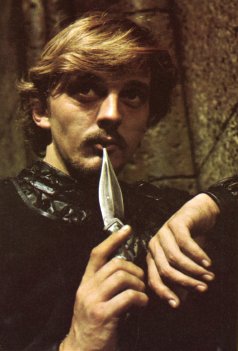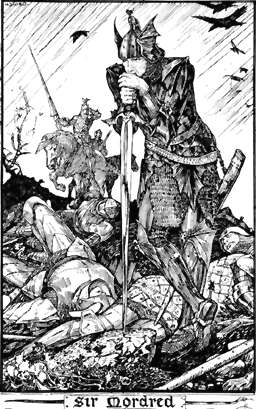Guenevere believed in family values...especially with her nephew/stepson Mordred. MORDRED? - I can hear jaws dropping: years of conditioning take their toll - Arthur's son by his sister Gwyar/Anna/Morgause (not by Morgen - that's a 20C notion)? - He was Guenevere's lover?
You can see him clearly, pale-faced and furtive, dressed in black, skulking in castle corridors. Even hostile writers usually allow him beauty of a doom-haunted kind: the pale young man leaning on his sword among a great heap of dead men, his damascened armour catching the last light of the sun.
The archetypal Celtic triangle tells of an old King, his young bride, his handsome, gifted nephew/lieutenant: Fionn, Grainne, Diarmaid; March, Essylt, Drustan; Conchobar, Deirdre, Naoise; and Arthur, Gwenhwyfar, Medrawd.
But after Lancelot's introduction, Mordred lost half his rôle in the story, leaving his rebellion against Arthur still to be explained. He degenerated into a sneaky, backstabbing (literally, in the case of Sir Lamorak), cowardly villain, while Lancelot made off with the glamour and Guenevere -
Wouldn't YOU be bitter?!
Modern authors have usually followed the French romance tradition, largely inspired by Malory et al., or have strayed even further. T H White, in his tetralogy The Once and Future King, portrayed Mordred as a Gaelic Fascist. In the film version of the musical Camelot, he is a malicious cynic - although David Hemmings' subtle performance hints that this masks a moralist's disillusion with the older generation's sexual hypocrisy. Catherine Christian, in The Sword and the Flame, made him Agravain's lover - using unpleasant prejudices about disloyalty and homosexuality. Equally dubiously, other modern writers have depicted him as in some way physically deformed - the outward shape mirroring the twisted soul, just as Shakespeare depicted Richard III. In 20C-21C, this simply will not do!
Celtic tradition indicates that, as Medrawd, Mordred was once a more noble and attractive character: a Brythonic Diarmaid/Naoise to Arthur's Fionn/Conchobar, a poet like the Pictish Drustan. Medrawd was one of 'The Three Kingly Warriors of Arthur's Court', famous for his courtesy, courage, virtue and gentleness - although his later elopement with Gwenhwyfar earned his listing as one of 'The Three Dishonoured Men of the Island of Britain'. Thomas Gray's poem The Bard, drawing on Welsh tradition, names him among the long-dead poets and harpers. My old edition of Palgrave's Golden Treasury is fazed by this, and suggests bizarrely in the notes that Gray really must mean Merlin! Some prejudices die hard!





